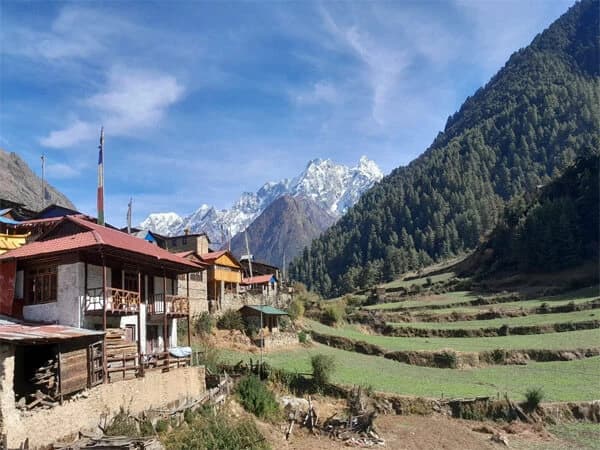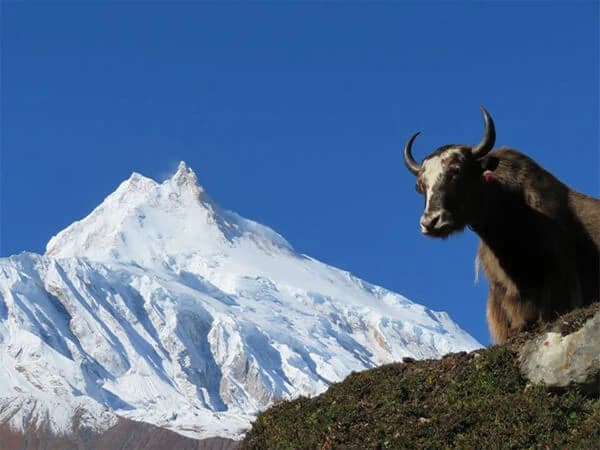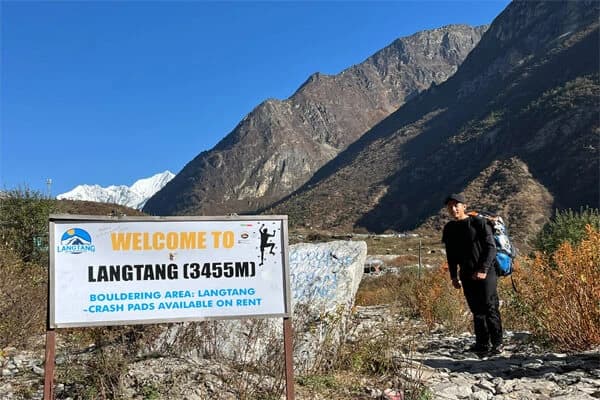The best time for Manaslu Tsum Valley trek is an important factor to consider before planning this adventure into one of Nepal’s most remote and culturally rich regions. Tucked up in the shadow of the eighth-highest peak in the world, Mt. Manaslu, this journey offers both deep cultural immersion in Tibetan-influenced settlements and stunning Himalayan views. Weather and seasonal circumstances have a significant impact on both safety and enjoyment because the trails traverse high mountain passes.
While the incorrect season can bring snow, rain, or landslides that make the journey more challenging, the perfect season guarantees bright skies, temperate temperatures, and dependable trekking routes. Since spring and fall offer the finest beauty and route accessibility, trekkers frequently choose these seasons. Even though they are less convenient, the winter and monsoon seasons provide special opportunities for people looking to travel or see different cultures. This blog will help you determine the ideal time of year to trekking to Manaslu Tsum Valley by guiding you through the seasonal differences.
Manaslu Tsum Valley Trek in Autumn
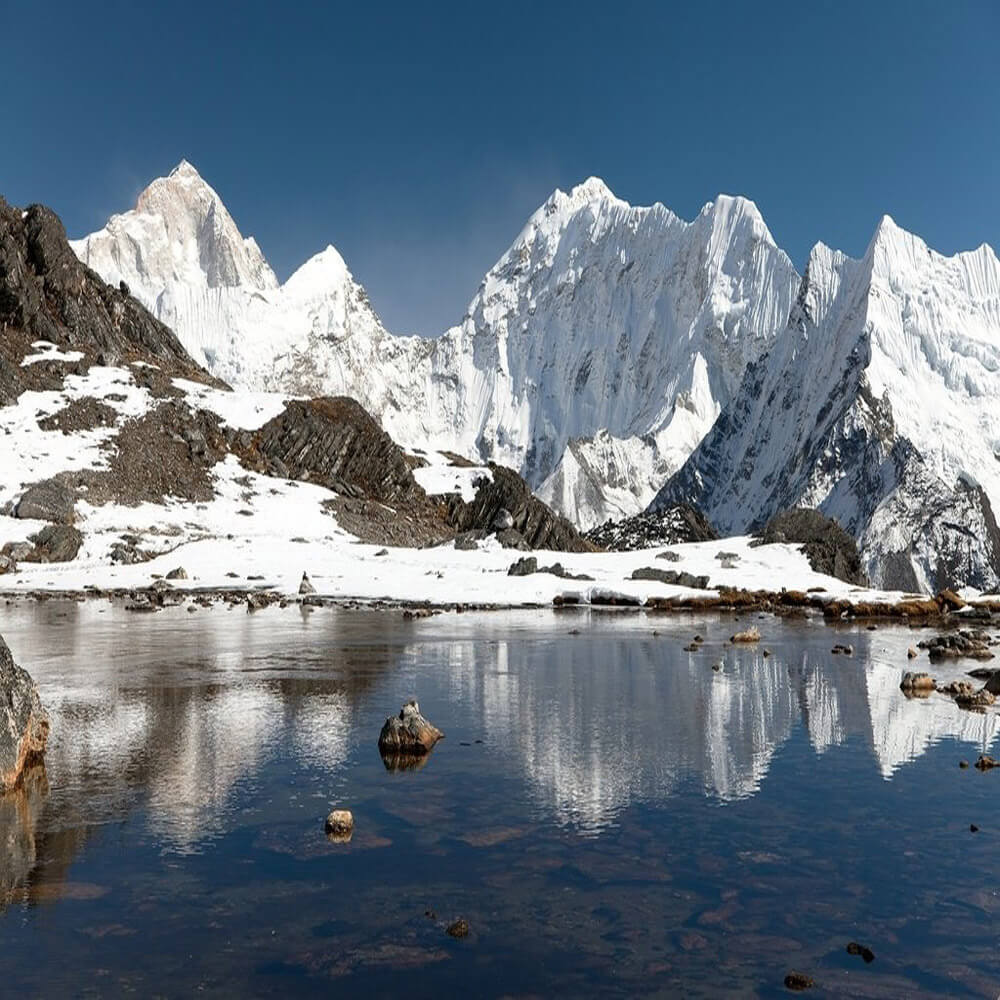
The Manaslu Tsum Valley Trek is particularly popular in the autumn, from September to November. The sky are pristine after the monsoon rains rid the air of dust and pollution. Trekkers can enjoy breathtaking sweeping views of Mt. Manaslu, Ganesh Himal, and the other peaks from this location. The rivers flow powerfully and the valleys appear alive and new, adding to the beauty of the surroundings. Because of these factors, it is one of the best seasons for taking pictures and enjoying the outdoors.
Manaslu Tsum Valley Trekking Weather
The consistent weather in the fall is another factor contributing to its reputation as the ideal season for Manaslu Tsum valley Trekking. In contrast to the more severe winter months, the days are bright and sunny, and the nights are cool but tolerable.
Cultural Festivals and Local Encounters
In Nepal, important celebrations like Dashain and Tihar take place in the fall. Trekkers may see or perhaps take part in these festivities, which highlight Nepal's rich culture and customs, while traveling through the villages in Tsum Valley. Together with the natural beauty, these festivals offer a unique cultural experience by uniting communities via music, dances, and traditions. This cultural immersion is just as fulfilling for many travelers as the scenery of the mountains.
Best Season for Manaslu Tsum Valley Trek
Autumn frequently comes to mind when people consider the ideal season for trekking in Nepal. The trekking environment is unparalleled because to the clear skies, comfortable temperatures, and joyous atmosphere. It should come as no surprise that these months see the highest traffic on the trails in Manaslu, Tsum Valley, and other areas like Everest and Annapurna. The vibrant atmosphere frequently enhances the whole Himalayan experience, despite the fact that it entails meeting more other trekkers.
The best season for Manaslu Tsum Valley is in the autumn. Trekkers can enjoy crystal-clear mountain views, reliable and safe weather, pleasant temperatures, and culturally interesting experiences it has everything they could possibly want. The benefits are worthwhile even if this time of year is busier and draws more trekkers. For those organizing a once-in-a-lifetime Himalayan journey, fall offers the ideal harmony of scenic splendor, security, and cultural exploration.
Manaslu Tsum Valley Trek in Spring Season
Manaslu Tsum Valley Trek Weather
Among the greatest seasons to trek to Manaslu Tsum Valley is spring, which runs from March to May. The weather is consistent and mild during this time, which makes it more pleasant to trekking trails. At higher elevations, the nights are cool but not freezing, while the days are warm enough for trekking. Rainfall is infrequent, unlike the monsoon, and heavy snowfall is less of an issue than in winter. Because of this equilibrium, spring is one of the most dependable times of year for fulfilling and safe Himalayan travel.
Blooming Rhododendrons and Green Valleys
One of the highlights of trekking in Nepal during spring is the breathtaking natural scenery. Forests abound with vibrant rhododendron blossoms, magnolias, and other wildflowers along the pathways in the Manaslu Tsum Valley. The snow-capped Himalayan peaks in the background create a stunning contrast with these vivid hues. After a long winter, the landscape feels new, the rivers are full, and the valleys are greener. For many trekkers, spring is the most visually satisfying season to visit the area because of the natural beauty and cultural diversity it offers.
Clear Views of the Himalayas
The great visibility in the spring is another benefit. Typically, the mornings are clear and provide breathtaking views of the surrounding valley's tall peaks, including Manaslu and Ganesh Himal. Light clouds may appear in the afternoon, although they hardly ever block the view for very long. Trekkers can take in unbroken mountain views, which makes sightseeing and photography very fulfilling. Because the springtime climate is more stable than during the monsoon or winter, there are more opportunities to consistently take in the breathtaking Himalayan scenery.
Ideal Time for Cultural Encounters
In addition to its mountains, the Manaslu Tsum Valley region is rich in Buddhist customs and culture. Trekkers get a rare chance to see real rituals, dances, and community meetings during spring, which frequently falls during local festivals and monastery celebrations. Villagers are more active in the fields and in day-to-day activities due to the beautiful weather, which facilitates and enhances relationships. Trekking in Nepal at this time of year gives both the natural beauty and a deeper cultural engagement.
Balanced Trails and Moderate Crowds
Although spring brings a moderate number of trekkers, autumn is the busiest trekking season. The paths provide for both isolation and camaraderie because they are vibrant without being crowded. With cozy accommodations and filling meals, tea houses and lodges are open and well-stocked. For those seeking a well-supported yet tranquil trekking experience, spring is especially alluring due to the mix between manageable crowds and accessible amenities.
Spring is one of the greatest times of year to trek the Manaslu Tsum Valley because it offers spectacular Himalayan views, blossoming landscapes, stable weather, and cultural contacts. For those who like to enjoy Nepal's best trekking without having to deal with the bitter cold of winter or the torrential rains of the monsoon, now is the ideal time of year.
Winter Trekking in Manaslu Tsum Valley
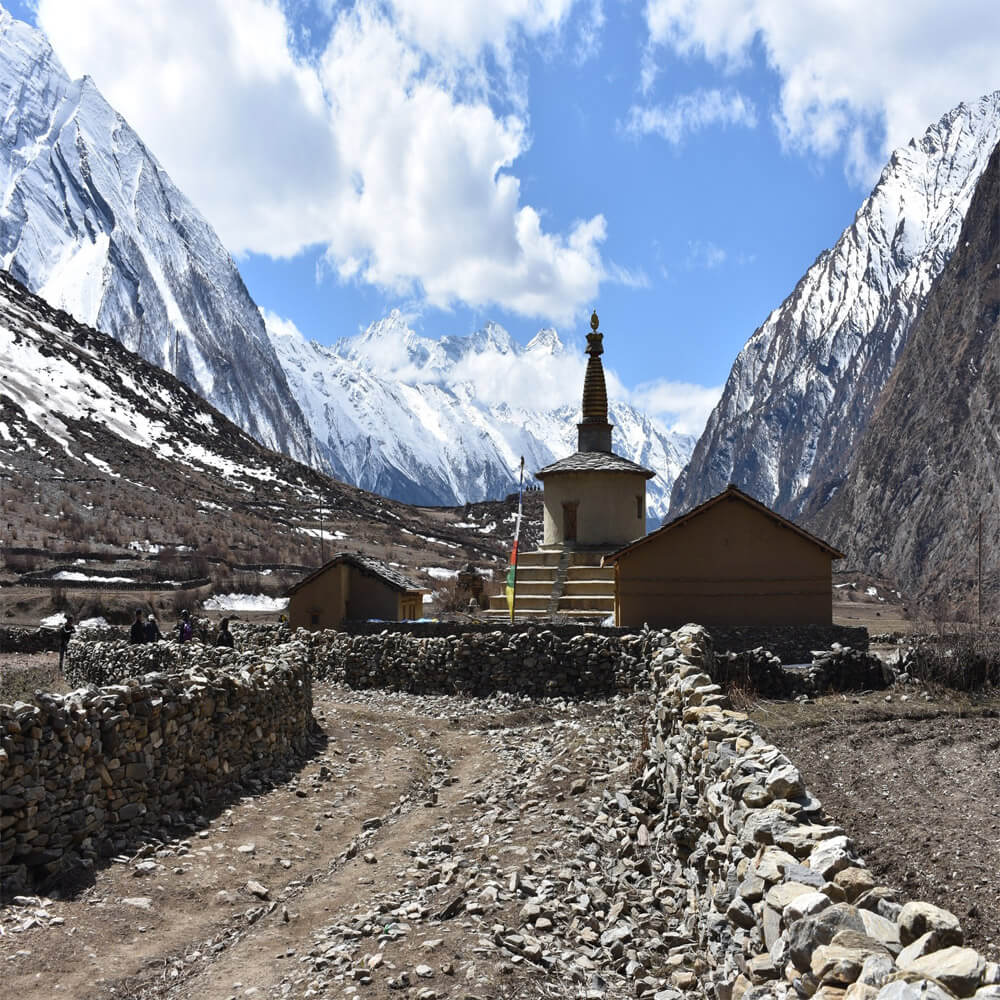
The Manaslu Tsum Valley Trek is not as popular in the winter (December to February), but for those who are prepared, it may be an incredibly adventurous experience. The crowded paths of fall and spring are not the same as trekking in Nepal during this time of year. It offers trekkers unparalleled serenity and seclusion, but it also presents difficulties like snow and harsh weather.
Clear Skies and Stunning Views
The clarity of the skies is one of the primary benefits of trekking in the winter. With peaks like Manaslu and Ganesh Himal appearing more beautiful than ever, the crystal-clear winter air frequently offers expansive views of the Himalayas. Photography is particularly gratifying because visibility is at its peak due to the less humid air.
Manaslu Tsum Valley Trek Temperatures and Snow
The cold is the largest obstacle to trekking in the winter. Temperatures can fall far below freezing at higher elevations, particularly at night. Snow frequently falls, especially close to high passes like Larkya La, making the paths more difficult and occasionally inaccessible. For comfort and safety, warm clothes, the right equipment, and mental preparation are crucial.
More tranquil trails and fewer crowds
Winter is the best season if you like to be alone. The trails are peaceful and quiet because so few trekkers select this time of year, in contrast to fall or spring. You can connect with local communities more deeply in villages and tea houses since they feel more genuine. Many experienced trekkers place a high emphasis on this tranquility.
Limited Facilities and Preparation
Another thing to think about is that, because of the severe weather, several tea houses and lodges in higher locations might close in the winter. This translates to simpler meals and fewer lodging options. Trekkers sometimes need to carry extra supplies and need to be adaptable. It is highly suggested to hire a guide or porter to assist with safety, navigation, and booking accommodations in open lodges.
Who Should Trek in Winter?
In the Manaslu Tsum Valley, winter trekking is hard for the faint of heart. It is better suited for seasoned explorers who can handle cold temperatures, long walking days, and difficult path conditions. A strong mentality, the appropriate equipment, and adequate physical preparation are crucial.
Though it may not be the most convenient season, the Manaslu Tsum Valley Trek offers a distinctive and fulfilling aspect of trekking in Nepal during the winter months. For brave trekkers seeking isolation, the clear skies, peaceful paths, and genuine cultural encounters make it worthwhile. Planning beforehand, dressing appropriately, and seeking advice from knowledgeable experts may make winter trekking an amazing experience that embodies the natural beauty and allure of the Himalayas.
Monsoon Season Tsum Valley Trek
Manaslu Tsum Valley Trek Weather
In Nepal, the monsoon season typically lasts from June to August. Heavy rains dominate most trekking routes, including the Manaslu Tsum Valley Trek, during this time. Rain frequently falls in the afternoon or evening, which can make routes muddy, slippery, and even hazardous. Clouds obscure the mountains in lower valleys, preventing trekkers from enjoying the picturesque vistas they seek. During this season, leeches on the trails, flooded rivers, and landslides are frequent problems. Because of these factors, many trekkers schedule their trips to avoid the monsoon.
Trekking in Nepal During Monsoon
The Manaslu Tsum Valley Trek is not thought to be best done during the monsoon, but there are still some special benefits to Trekking in Nepal during this time of year. The landscape is more colorful than at any other time of year, the valleys turn lush green, and the waterfalls roar to life. Because there are fewer tourists in the villages, cultural experiences also feel more genuine. Even though the mountain peaks are sometimes obscured, the lush vegetation and gloomy skies make for striking backgrounds for photographers.
Suitability for the Manaslu Tsum Valley Trek
Unlike Upper Mustang or Upper Dolpo, the Manaslu and Tsum areas receive a lot of rainfall since they are not in the rain-shadow area. Therefore, it is generally not advised to trek here during the monsoon unless one is very interested in village homestays or cultural exploration. Because of landslides or blocked paths, the high passes can be dangerous and cause itinerary disruptions. Trekkers may still be able to walk at lower elevations, but they will need to be adaptable and patient with unforeseen setbacks.
Who Might Consider Monsoon Trekking
Travelers who are more interested in cultural immersion and less bothered with expansive mountain vistas are the ideal candidates for monsoon trekking in the Manaslu Tsum Valley. The season may nevertheless be fulfilling for those who want to take part in village festivities, experience the farming way of life of the locals, or walk along uncrowded, peaceful trails. However, to guarantee safety and navigation on hazardous portions of the trail, such trekkers should always accompany an expert guide.
The Manaslu Tsum Valley Trek is generally not advised during the rainy season. It is not suited for most trekkers because to the mix of leeches, muddy terrain, severe rainfall, and restricted mountain vistas. However, with the right planning, waterproof equipment, and expert advice, it can provide a completely new viewpoint on trekking in Nepal Himalaya. Trekking the Manaslu Tsum Valley during the monsoon season may have a special allure for daring tourists seeking seclusion and cultural depth, even if autumn and spring are still the ideal times of year for this walk.
Climate of the Manaslu Tsum Valley Region
The Manaslu Tsum Valley region has a varied climate due to its wide range of altitudes, from lower villages around 600–1,000 meters to high passes and the base camp over 4,800 meters. The weather is comparatively warm and temperate in the lower valleys. While evenings might be chilly, days are often mild with pleasant walking temperatures. These regions receive a moderate amount of rainfall, which keeps the fields and forests green.
The temperature gets drier and colder as you go higher in the sky. The air is less humid and thinner, which causes temperatures to drop considerably, particularly at night. Even when lower valleys are clear, snow might still fall in upper areas. Strong gusts in the high mountains might cause the temperature to feel lower than what the thermometer reads.
Trekkers frequently encounter significant temperature variations throughout the journey between sunny slopes and shady sections, as well as between day and night. To keep warm, cozy, and sun-protected, this calls for layering garments. Rapid weather changes are also typical; in the high valleys, sunny mornings often give way to gloomy or foggy afternoons.
Despite these difficulties, the Tsum Valley's climate is generally suitable for trekking, with pleasant weather in the lower elevations and dry, crisp air at higher elevations. Trekkers can safely traverse the varied circumstances while taking in breathtaking views of the mountains, forests, and cultural communities along the way with the aid of adequate preparation, acclimatization, and adaptable planning.
Seasonal Guide for Tsum Valley Trek
Seasonal weather patterns have a big impact on the Manaslu Tsum Valley Trek, just like they do on other Himalaya. Even during the busiest trekking seasons, the Tsum Valley is still comparatively less crowded than more well-traveled routes like the Annapurna Circuit or Everest Base Camp.
Like the Annapurna and Everest regions, trekkers enjoy warmer temperatures and blooming rhododendrons in the spring. The high-altitude trails are generally clear and provide great views of Manaslu and the surrounding peaks, while the lower valleys are lush. Although there may be sporadic clouds in the afternoon, the days for trekking are pleasant and the mornings are typically clear.
Similar to most major treks in Nepal, the Tsum Valley is best visited in the autumn. It is perfect for photography and taking in expansive mountain views because of the clear skies, steady weather, and crisp air. There is less chance of landslides and the trails are drier. Because there are less trekkers in the Tsum Valley than on Everest or Annapurna, the trip is more serene and engaging.
Compared to climbs at lower elevations, such as Ghorepani Poon Hill, the Tsum Valley experiences colder winters. Unlike Annapurna Base Camp or Langtang Valley, which are somewhat possible with the right equipment, snow can block high passes, making some sections challenging or impassable.
Heavy rains, slippery roads, and the possibility of landslides are all part of the monsoon season. Trekking in the Tsum Valley is dangerous and less pleasurable because to the heavy impact, in contrast to rain-shadow areas like Upper Mustang.
All things considered, trekking to Tsum Valley is more peaceful and culturally rich. The finest seasons are spring and fall; winter calls for planning, and monsoon is best avoided. It is a less popular but no less amazing journey than Everest or Annapurna, perfect for people looking for both adventure and peace.
Manaslu Tsum Valley Trek Difficulty by Season
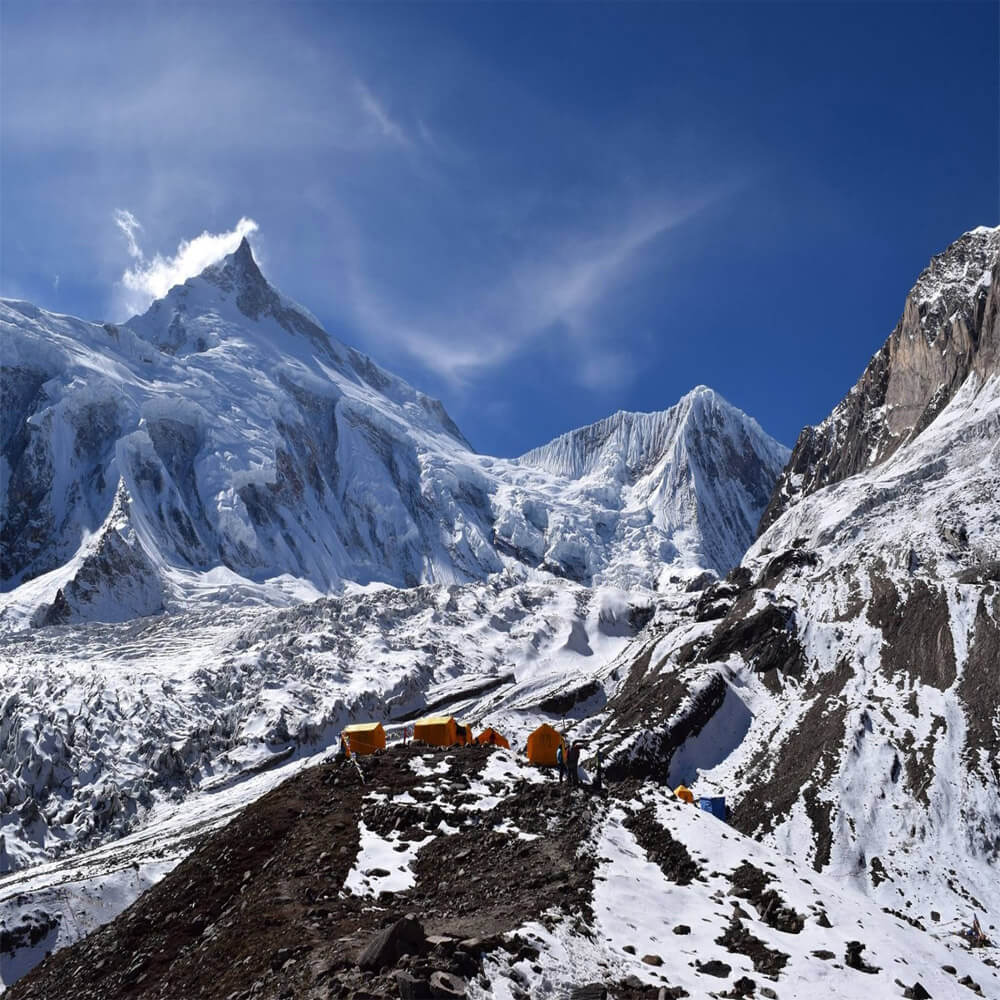
Due in significant part to weather, trail conditions, and altitude difficulties, the Manaslu Tsum Valley Trek's difficulty fluctuates with the seasons. The overall rating for this journey is moderate to tough, making it appropriate for trekkers who are well-prepared, have prior experience, and are in good physical condition.
Trekking is easier in the spring than it is in the rainy season since the pathways are usually dry and clear. There is less chance of slipping throughout the day because of the milder temperatures and more stable pathways. Higher elevations still require acclimation because of issues like thinner air and the possibility of altitude sickness. Because the temperature is mild and the scenery is colorful with rhododendrons in bloom, spring is a nice time of year for beginners with moderate expertise.
Since autumn is the busiest trekking season, the trek is a little more difficult in terms of numbers. Although the trails are dry and have good visibility, which makes navigating easier, having too many trekkers on them can slow down progress and make trekking more mentally taxing. In spite of this, many people believe that the Manaslu Tsum Valley Trek is more comfortable and safe during the fall.
Winter makes things much more difficult. High-altitude portions are more difficult to navigate due to snow, slippery trails, and bitterly cold weather. Although they are still reachable, lower-altitude regions are still frigid and call for more clothing and equipment. Logistically, limited tea house availability makes things more difficult.
The most challenging season is monsoon. In addition to making trails slippery, heavy rains raise the possibility of landslides, river crossings, and trail erosion. Wet conditions and high humidity can be draining, making walking considerably more difficult.
Therefore, spring and fall are the most convenient and secure trekking seasons, winter necessitates planning and experience, and the monsoon season poses significant logistical and physical difficulties. In every season, careful preparation, acclimatization, and assistance from guides or organizations like Nepal Trekking Routes are essential.
Tips for choosing the right season
- Check the Weather Forecasts: Before planning your trek, always research the weather trends for your chosen season. Autumn and spring offer the most stable conditions, while winter and monsoon bring extra challenges.
- Understand Your Trekking Level: Beginners may prefer autumn or spring for comfort and safety. Experienced trekkers who enjoy solitude might explore winter or even off-season conditions with proper preparation.
- Prepare for Altitude: Regardless of the season, acclimatization is essential. Include rest days in your itinerary to avoid altitude sickness.
- Plan for Safety: Trails can change with the season. In winter, high passes may close due to snow; during monsoon, landslides and slippery trails are common. Always check local updates.
- Book Early in Peak Season: Autumn and spring are busy, so book tea houses, guides, and permits in advance to secure your trek.
- Consider Cultural Experiences: Monsoon is not ideal for mountain views, but it’s a good time for cultural exploration in Tsum Valley, as the fields are green and villages lively.
- Hire Local Guides and Porters: They provide safety, handle logistics, and share cultural insights, especially useful when conditions are unpredictable.
- Stay Flexible: Weather in the Himalayas can change quickly. Have buffer days in your schedule for delays.
- Match the Season to Your Goals: If you want clear mountain views, choose autumn. For blooming flowers, spring is best. For solitude, winter works. For culture, monsoon offers a unique glimpse.
- Pack Season-Specific Gear:
- Autumn/Spring – Lightweight layers, good trekking boots, and rain protection.
- Winter – Heavy down jackets, thermal wear, gloves, and sleeping bags for extreme cold.
- Monsoon – Waterproof gear, leech socks, and quick-dry clothing.
Conclusion: Best season for Manaslu Tsum Valley Trek
The rewarding Manaslu Tsum Valley Trek blends off-the-beaten-path adventure, cultural exploration, and Himalayan grandeur. While each season has its own character, autumn (September–November) and spring (March–May) stand out as the best times to visit. While spring gives bright rhododendrons and good trekking conditions, autumn offers clear skies, consistent weather, and ideal mountain views. Experienced trekkers who are prepared for snow and colder temperatures may find winter to be appropriate, and monsoon is typically avoided because of the trail's difficulties and excessive rainfall.
Selecting the appropriate season guarantees the greatest overall enjoyment, comfort, and safety. Trekkers can schedule their trip based on the season that best suits their expectations, interests, and level of fitness with the help of advice from our company, Nepal Trekking Routes. In any well considered season, the Manaslu Tsum Valley Trek is a wonderful experience thanks to the expertise of our crew, which offers appropriate logistics, safety assistance, and cultural insights.
Frequently Asked Question
When is the best time to trek the Manaslu Tsum Valley?
The most favorable trekking seasons are spring (March–May) and autumn (September–November). These months offer clear skies, stable weather, and excellent visibility for mountain views.
Can beginners trek during these seasons?
Yes, spring and autumn provide manageable weather and trail conditions, making the trek suitable for beginners with moderate fitness. Acclimatization and proper preparation are still essential.
Is trekking in winter possible in the Tsum Valley?
Winter is possible for experienced trekkers, but the difficulty increases due to snow, icy trails, and cold temperatures. Lower-altitude sections are easier, but high passes may be blocked.
Should I avoid trekking during the monsoon season?
Yes, the monsoon (June–August) is generally not recommended. Heavy rainfall, landslides, and slippery trails make trekking risky, although lower-altitude cultural exploration is still feasible.
How does the season affect accommodations and logistics?
During spring and autumn, tea houses are fully operational, but may be crowded. In winter and monsoon, fewer accommodations are open, and services can be limited. Hiring a local guide or our agency, Nepal Trekking Routes ensures proper planning and safety regardless of the season.





